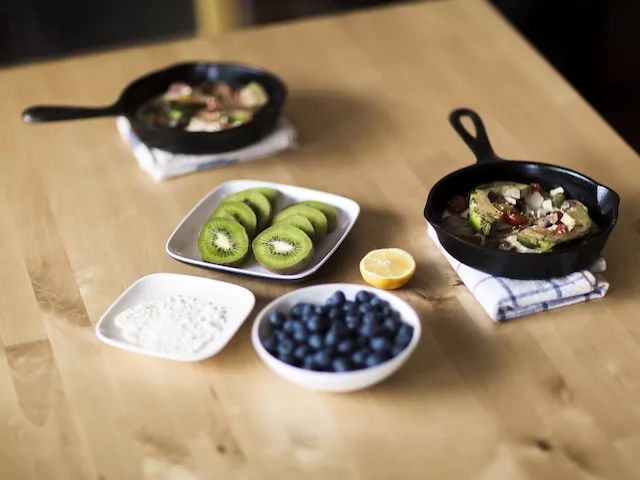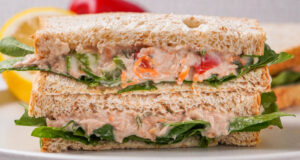When it comes to weight loss, we all too often focus on restriction and what we “shouldn’t” eat. However, sometimes adding the right things into your diet can tip the scales in your favor—no deprivation required. According to one of the latest TikTok trends, it only takes some simple math to not only lose weight but also boost satiety, increase muscle mass, and then some. Enter: the 90-30-50 diet.
Ahead, we’re covering everything you need to know about this trending diet—including the benefits of macronutrient balance, sample menus, and if dietitians ultimately give it the green light.
What Is the 90-30-50 Diet?
Created by Courtney Cassis, MS, RD, LDN, the 90-30-50 diet involves hitting the following macronutrient targets daily:
According to Cassis, this basic formula has the ability to support weight loss, improve certain chronic conditions, balance hormones, control blood sugar control, and more—all within weeks, if not days, of kickoff. Cassis herself claims to have lost 15 pounds in two months by following this protocol—and her clients (plus legions of followers) are adding up their own macros to follow suit.
“Each of these macronutrient targets plays a role in supporting weight loss, but their impact varies depending on individual needs and the overall context of one’s diet,” says Amy Shapiro, MS, RD, of Real Nutrition in New York City.
Benefits of the 90-30-50 Diet for Weight Loss
According to Kristen Lorenz, RD, the 90-30-50 diet is an approachable and well-rounded framework for weight management and metabolic health. “Unlike extreme calorie restrictions or rigid trends, it’s sustainable and flexible,” she shares. “It also offers nutritional balance. With protein to preserve muscle, fiber to support gut health, and healthy fats for hormone balance, this diet covers the essentials without demonizing any food groups.”
Here’s how each macronutrient and target amount can inch you toward your weight-loss goals.
Protein
Protein is crucial for maintaining lean muscle mass for all, but Shapiro says this rings especially true for those who are in a calorie deficit for weight loss. “It also increases satiety, which can help reduce overall calorie intake,” she continues. “For many people, hitting 90 grams of protein a day is a good target to support muscle retention and avoid muscle loss while losing weight.”
Fortunately, there’s no shortage of animal- and plant-based foods to help you eat more protein daily. You can prioritize the macro for meals and snacks alike—including by mixing HUM’s Core Strength low-FODMAP, plant protein powder into smoothies and baked goods.
Caveat: Shapiro says that 90 grams of protein may be high for some people based on their current weight and activity level. “If you’re sedentary or have lower muscle mass, you may not need this much, and a more individualized target based on your weight or lean body mass might be better,” she shares. “Typically, around 1.2 to 2 grams of protein per kilogram of body weight is a more reasonable range for active people.” (For an active person weighing 150 pounds, this could range from 82 to 136 grams daily.)
Fiber
A mere 7 percent (or less) of adults in the United States eat enough fiber daily, which is bad news for achieving your weight-loss goals and minding your greater health alike. (ICYMI, fiber is crucial for everything from promoting healthy digestion and nurturing your gut microbiome to lowering your risk for cardiovascular disease.)
“Fiber helps slow digestion to keep you feeling fuller for longer, which can prevent overeating, cravings, and snacking,” Shapiro adds. “Fiber-rich foods are often nutrient-dense, which is beneficial for weight loss, and 30 grams is a good baseline for many adults and is aligned with general dietary guidelines for fiber intake.”
To boost your fiber intake, aim to eat more fruits, veggies, legumes, whole grains, nuts, and seeds. You can also rely on HUM’s Flatter Me Fiber GLP-1 Booster, which offers a solid 5 grams of Fibersol vegetable fiber per 2 teaspoon serving.
Caveat: If your diet is currently low in fiber, gradually increase your intake to avoid triggering or exacerbating digestive distress. Also drink plenty of water to help move things along. Again, while 30 grams clocks in near the recommended range of how much fiber you should eat daily (25 grams for women and 38 grams for men, per the USDA), this amount isn’t failproof for everyone. “For some people, 30 grams might be too high if they have a sensitive gut or suffer from certain digestive issues like IBS,” Shapiro explains.
Healthy Fats
Last but not least, healthy fats factor into the 90-30-50 equation. “Healthy fats are essential for hormonal balance, brain function, and overall health,” says Shapiro. “Eating sufficient fats can also help with satiety, making it easier to maintain a calorie deficit.”
Shapiro says that 50 grams is a moderate daily target, emphasizing that these fat sources should primarily come from whole foods such as:
- Avocados
- Oily fish
- Nuts
- Seeds
Caveat: According to Shapiro, people may require more or less fat based on their individual metabolic needs and energy levels. (People who do HIIT training or endurance sports, for instance, may need to aim for a higher daily intake.) “Fats are also calorie-dense, so even if you’re hitting these targets, you still need to be mindful of total calorie intake for weight loss,” she adds.
90-30-50 Sample Meal Plan


To give you an idea of what a day’s worth of meals and snacks could look like on the 90-30-50 diet, Lorenz helpfully shares the menu below. (Of course, you’re encouraged to switch things up for the sake of dietary diversity, pleasing your palate, and food restrictions—so sub in your preferred high-protein, fiber-rich, and healthy fat staples as you wish.)
Breakfast: Veggie Omelet with Avocado
Approx. 18g protein, 4g fiber, 27g fat
- 3 large eggs (18g protein, 15g fat)
- 1 cup spinach (1g fiber)
- 1/2 cup mushrooms (1g fiber)
- 1/4 avocado (2g fiber, 7g fat)
- 1 tsp olive oil (5g fat)
Snack: Chia Pudding
Approx. 6g protein, 10g fiber, 12g fat
- 3 tbsp chia seeds (6g protein, 10g fiber, 12g fat)
- 1 cup unsweetened almond milk
- 1 tsp honey (optional)
Lunch: Turkey + Hummus Wrap
Approx. 39g protein, 6g fiber, 5g fat
- 4 oz sliced turkey breast (32g protein, 2g fat)
- 1 whole-grain wrap (5g fiber, 5g protein)
- 2 tbsp hummus (2g protein, 3g fat)
- Mixed greens and cucumber (1g fiber)
Snack: Apple with Almond Butter
Approx. 3g protein, 4g fiber, 9g fat
- 1 medium apple (4g fiber)
- 1 tbsp almond butter (3g protein, 9g fat)
Dinner: Grilled Shrimp with Quinoa + Asparagus
Approx. 34g protein, 5.5g fiber, 9g fat
- 5 oz grilled shrimp (30g protein, 2g fat)
- 1/2 cup cooked quinoa (4g protein, 2.5g fiber, 2g fat)
- 1 cup roasted asparagus (3g fiber)
- 1 tsp olive oil (5g fat)
Takeaways + Tips
Both dietitians believe that the 90-30-50 method can support weight and wellness goals, and consider it to be among the superior diet plans making their rounds on TikTok. “For those inspired by social media trends, this diet is a grounded and sustainable alternative focusing on long-term health over fleeting fads,” says Lorenz. “It’s a great starting point for anyone ready to improve their nutrition without the stress of overly restrictive rules. It also aligns well with the principles of metabolic health and longevity.”
That said, there are a handful of FYIs and tips you’ll want to heed to amplify your success on this plan.
To start, it’s crucial to ensure that your macros come from whole, high-quality sources as much as possible. “With diets high in protein and fiber trending these days, more ultra-processed foods are claiming to be good sources,” Shapiro cautions. “For example, filling up on energy bars that are high in fiber and protein is not the same as eating salmon, vegetables, and whole grains.”
Next, both dietitians emphasize how important individualized approaches are to nutrition. “Everyone is different, and in my practice, we design diets based on height, weight, weight goals, activity level, season, etc. No two people are the same,” Shapiro shares. As such, she advises enlisting the help of a registered dietitian, who can help you with food lists, recipes, and specific guidelines for your personalized needs.
Finally, listening to your body—including your hunger cues, energy levels, and how your body responds to specific foods and food groups—is even more important than consuming a specific amount of macros on a given day. Shapiro reminds us that you’ll still need to abide by healthy habits like meal timing, also noting that not all days will be the same. “Some may thrive with more or fewer carbs, fats, or protein,” Lorenz adds, “so don’t hesitate to tweak based on hunger, energy, and feelings.”
90-30-50 Diet FAQs
Can the 90-30-50 diet work for everyone?
“As a registered dietitian, I’d recommend these diet guidelines to anyone seeking a balanced approach to nutrition,” says Lorenz. However, individualization based on a range of personal factors is key for any and every diet.
“While the 90-30-50 diet breakdown is ideal for some, it certainly isn’t one-size-fits-all,” says Shapiro. “For example, if 90 grams of protein is too much or too little, you will not meet your overall goals as efficiently as you would if a program is designed for you,” Lorenz adds that any medical conditions should also be taken into account before starting this diet.
How do I calculate my macros to ensure I’m hitting these targets?
To hit your targets on the 90-30-50 diet, you can:
- Read labels on packaged foods
- Look up nutrition facts on the USDA’s FoodData Central
- Use a food-tracking app to look up and log your meals and snacks
- Work with a dietitian who can calculate the macros of your preferred foods
Are there any risks associated with this diet?
Generally speaking, the 90-30-50 method is a well-rounded dietary plan for weight loss and overall well-being. “While the main idea here (i.e., eating a diet rich in protein, fiber, and healthy fats) is excellent, giving specific numbers can lead to overthinking, disordered eating, fear of not succeeding, and even loneliness as individuals may refrain from dining out or eating with friends in order to hit their goals,” Shapiro warns.
With this in mind, consider the 90-30-50 method to be a helpful framework for most days, rather than an absolute necessity all the time.
Can I follow the 90-30-50 diet as a vegetarian or vegan?
The 90-30-50 diet is highly flexible, including for those on plant-based diets and other needs. “It’s adaptable to various dietary preferences, including vegetarian or gluten-free lifestyles,” says Lorenz.




